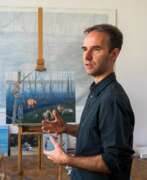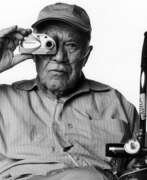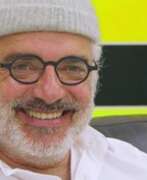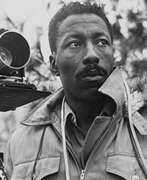Reportage Contemporary art


Tilo Baumgärtel is a German artist who lives and works in Leipzig.
His paintings go back to the works of social realism and large-format propaganda posters. The artist works with a variety of mediums and techniques. In addition to painting, he also uses lithography, drawings on paper, and video. Pictorial space and the creation of sometimes surrealistic landscapes is one of his central themes.
Tilo Baumgärtel also collaborates with theaters, developing sets and videos on scenography.


Armin Boehm is a German artist who lives and works in Berlin.
In his works, Boehm explores the connections between the urban and natural environments of modern man. He creates a fantastic urban space filled with cyborgs, politicians and flowers. In the collage technique the artist combines fragments of color, fabric, paper or metal substances from which his paintings grow. He mixes elements of pop culture and art history, architecture and literature, contemporary politics and fantasy.


Édouard Boubat was a French photojournalist and art photographer.
In 1943, he was subjected to service du travail obligatoire, forced labour of French people in Nazi Germany, and witnessed some of the horrors of World War II. He took his first photograph after the war in 1946 and was awarded the Kodak Prize the following year. He travelled internationally for the French magazine Réalités, where his colleague was Jean-Philippe Charbonnier, and later worked as a freelance photographer. French poet Jacques Prévert called him a "peace correspondent" as he was humanist, apolitical and photographed uplifting subjects.


Miguel Rio Branco, full name Miguel da Silva Paranhos do Rio Branco, is a Brazilian photographer, artist, director and creator of multimedia installations.
His father was a diplomat and as a child Miguel lived in Spain, Portugal, Switzerland and the USA, now living and working in Rio de Janeiro, Brazil. After earning a degree in photography from the New York Institute of Photography, Miguel first worked as a cameraman and then worked with the Magnum agency. Miguel is known for exploring and crossing two different art forms: painting and photography. He has also shot 14 short films and eight long films, he is recognized in the world as one of the best color photojournalists.
Miguel Rio Branco's photographs are part of the collections of the Museum of Modern Art and the Metropolitan Museum of Art in New York.


Raymond Redvers Briggs was a British writer, illustrator, and cartoonist.
A professional illustrator, he worked on the design of children's books. In the 1960s, Briggs discovered his talent and ability to combine words and pictures, using a form of strip cartooning that defined his later work.
Briggs is best known for his wordless book The Snowman, published in 1978, a sort of cute children's tale but with deep meaning. The animated and musical versions of this book are popular in Britain and are shown annually at Christmas.


Jörg Döring is a German mixed media artist, one of Germany's leading neo-pop artists. Using screen printing, silkscreening, photo collage, acrylic, spray paint and oil on canvas, Döring depicts various comic, cartoon characters and pop icons. The source materials for his work are photographs, books, old magazines, drafts, print samples, packaging, sketches and more, from which he creates large-scale and multimedia works.


Armen Eloyan is an Armenian-born painter who lives and works in Zurich. He is known for his large-scale, hooligan depictions of anthropomorphic animals and figures, absurdist narratives in dark, existential works. His creations are inspired by caricature and street art, as well as by European masters.


Hans Fronius was an Austrian painter and illustrator. His work is considered an example of "expressive realism," and he painted portraits, street scenes, and literary interpretations. Fronius was one of the first to illustrate stories by Franz Kafka, as well as works by Edgar Allan Poe and Robert Louis Stevenson.


Fritz Genkinger is a German artist, member of the German Association of Artists.
He participated in the 1972 Munich Olympics as a draughtsman and designed the posters for the World Championships.
A versatile creator, Genkinger was, among other things, fascinated by Bettingen marble, from which he even carved clear-sounding stone flutes.


David Goldblatt was a South African photographer noted for his portrayal of South Africa during the period of apartheid. After apartheid had ended he concentrated more on the country's landscapes. What differentiates Goldblatt's body of work from those of other anti-apartheid artists is that he photographed issues that went beyond the violent events of apartheid and reflected the conditions that led up to them.


William Gropper was an American cartoonist, lithographer, and graphic artist who studied under Robert Henry and George Bellows. As a socialist, he spent his life creating satirical images about greed and exploitation, war, and prejudice. The artist visited the USSR in the 1920s, and the main subjects of his work in the 1930s were the international labor movement and anti-fascist cartoons. He collaborated with many Communist-oriented American publications. Glopper is known not only for his caricatures, but also for his book illustrations, posters, monumental and easel paintings.


Albert Guillaume was a French artist, cartoonist, illustrator, and master of the poster.
Guillaume was a prolific illustrator: he worked for magazines, books, and almanacs, and his satirical drawings were published in Parisian humor magazines. He was also a painter and designer of theater posters and advertising posters. Working for the large Parisian printing company Camis, he designed a series of highly successful posters for commercial goods.


Wolfgang Herzig was an Austrian painter and sculptor known for his critical portrayal of social realities. In his figurative paintings he draws attention to human weaknesses in everyday life.
There is a sense of social criticism in Herzig's work, but he never turns his characters into caricatures. Over time, the artist came to a peculiar two-dimensional form of plastics.


Robert Hill Jackson or Bob Jackson is a Pulitzer Prize-winning American photographer.
Robert attended Southern Methodist University while pursuing a passion for photography. While serving in the National Guard, Jackson became a photographer for an Army general. In 1960, he began working as a photo reporter for the Dallas Times Herald newspaper.
On November 22, 1963, Jackson was assigned to cover President John F. Kennedy's arrival at Love Field and his motorcade through the city. He witnessed Kennedy's assassination, but did not have time to film it. Two days later, however, he was able to photograph the shooting of Lee Harvey Oswald, the accused assassin of President Lee Harvey Oswald, by Jack Ruby in the garage of the Dallas police station. Robert Jackson was awarded the 1964 Pulitzer Prize in Photography for these photographs.


Wilhelm Kaufmann is an Austrian artist who has been called the master of the moment.
He studied at the Imperial Royal Academy of Fine Arts, then worked as a painter and track and field athlete at the same time. Kaufmann used color dynamics to masterfully depict momentary scenes of athletes' movements during competitions. He also painted colorful still lifes, landscapes and portraits.
Wilhelm Kaufmann was a member of the Professional Association of Austrian Visual Artists, the Sonderbund of Austrian Artists, the Vienna Art Association and the Vienna Hagenbund, the Vienna Secession and the Vienna Society of Artists, Künstlerhaus.


William Klein was an American-born French photographer and filmmaker noted for his ironic approach to both media and his extensive use of unusual photographic techniques in the context of photojournalism and fashion photography. He was ranked 25th on Professional Photographer's list of 100 most influential photographers.
Klein trained as a painter, studying under Fernand Léger, and found early success with exhibitions of his work. He soon moved on to photography and achieved widespread fame as a fashion photographer for Vogue and for his photo essays on various cities. He directed feature-length fiction films, numerous short and feature-length documentaries and produced over 250 television commercials.


Stefan Moses was a German photographer living in Munich.
His documentary portraits of people and professions in West Germany (Germans) and later in East Germany (Farewell and Beginnings) made him accessible to a large audience. Moses took people out of their working environment and photographed them in front of a grey linen cloth — thus creating contemporary documents.


Richard Mosse is an Irish conceptual documentary photographer living in New York and Ireland.
He has a BA from King's College London and an MA in Photography from Yale University and has worked in Iraq, Iran, Pakistan, Palestine, Haiti and the former Yugoslavia. Moss' photographs and films document armed conflicts, humanitarian crises and environmental crimes.
Moss works to visualize events, technologies and systems that often remain invisible, using a camera equipped with thermal imaging technology that obscures, abstracts and brings violence to the fore.


Magdalo Mussio is an Italian artist, animator, editor and writer.
In painting he created abstract landscapes and participated in many exhibitions in Italy. In the 1960s he worked as an editor for several Italian cultural publications. Mussio was also the creative artist of a number of animated films and published several books about his work.


Carmen Oberst is a German artist, graphic designer and photographer.
She has lived in Hamburg since 1980 and works as an independent photographic artist, curator and teacher of design using photographic media.
Carmen Oberst originally worked as a graphic designer. Since 1997 she has been active in photography and experimental film, holding numerous exhibitions at home and abroad. Back in the 1980s, she developed her own visual language based on analog black and white photography and photoalchemical experiments. And in 1996 she founded PHOTO.KUNST.RAUM, a center for fine art photography and fine art known outside Hamburg.
Carmen Oberst turns the world into a stage: she routinely uses found events and randomly present people to create a fantastical production from the group of works "Rods of Imagination - On the Road" through the medium of photography.


Serban Savu is a Romanian artist living and working in Cluj, Romania.
He is one of the main representatives of the so-called Cluj School of painting. Savu is known for his figurative paintings depicting the life of Romanians today: how people work and rest, go on dates, grieve and rejoice. The artist also depicts the consequences of the social and economic crisis in the country.


Jakob Sollberger is a Swiss painter and graphic artist, sculptor, photographer and video director.
Initially Jakob was very interested in video and photography, and at the age of 26 he founded his own studio for advertising photography and production of industrial films and TV commercials. A few years later he took up other art forms as well.
Since the early 1990s, Sollberger has taught photography courses at the Zurich Education Center and has created many photographic portraits. In recent years, Jakob Sollberger has also worked on short films on various subjects.


Philip "Snapdragon" Stern was an American photographer noted for his iconic portraits of Hollywood stars, as well as his war photography while serving as a U.S. Army Ranger with "Darby's Rangers" during the North African and Italian campaigns in World War II.


Wil van der Laan is a Dutch painter and sculptor.
His paintings and sculptures are very expressive and dynamic. Wil van der Laan masterfully depicts in his style the tensions of sports moments, the beauty of the Malian peoples, the power of the bulls' movement and the serenity of the resting cheetahs.
The sculptures of van der Laan can be seen not only in private collections, but also in public places in the Netherlands.


Renzo Vespignani was an Italian painter, printmaker, and illustrator, co-founder of II Pro e II Contro (Pro and Con), which sought to develop new directions in neo-realism. Vespignani's 1944 drawings realistically depicted the destruction of German-occupied Rome. He also illustrated works by Boccaccio, Kafka, and T. S. Eliot.


David Yarrow is a British photographer, conservationist and writer.
At the beginning of his career Yarrow photographed sports stars, at the age of only 20 he took the iconic picture of soccer player Diego Maradona, but then he found his niche. David Yarrow reinvented wildlife photography with his extraordinary patience and, most importantly, his reverence for it. Yarrow's black-and-white wildlife photographs with stars such as Cindy Crawford and Cara Delevingne have brought him ever-growing popularity among collectors. Today he is the best-selling photographic artist in the world.
Yarrow is also active in his charity work for the protection of wildlife.

























